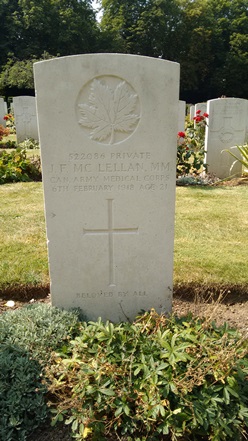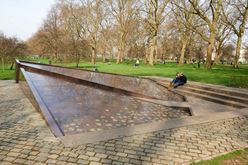 Geologist and science writer Nina Morgan recounts the mixed fortunes of the Canada Memorial in London
Geologist and science writer Nina Morgan recounts the mixed fortunes of the Canada Memorial in London
Epitaphs, restricted to no more than 66 characters, were the only personal touches relatives were allowed to add to the standard Portland Stone war grave headstones designed by the Commonwealth War Graves Commission (see 'War Graves 'Design by Committee' got it right', Geoscientist 24.10, November 2014).
Picture: Canadian war grave in the CWG cemetery in Botley, Oxford. Photo: Nina Morgan.
But not all war graves bear personal inscriptions. There are several reasons for this. Some countries, such as New Zealand, concerned that inscriptions might infringe the Commission's principle of equality, decided not to allow epitaphs. Others, such as Britain and Australia, placed strict restrictions on length and wording, and charged grieving relatives – some of whom could not afford to pay – for every letter and space, like a telegram. The Canadian government, in contrast, took a more liberal view, and agreed to pay for all their soldiers' inscriptions.
However, when it came to paying for a public monument in London to honour their war dead, the Canadian government seems to have taken a different view. A memorial, in the shape of an open rotunda of Portland stone, was erected by the Commonwealth War Graves Commission in 1958 in Brookwood Military Cemetery near Pirbright in Surrey to honour all Commonwealth and Empire war dead from WW2. However, there appears to have been no government-backed move to erect a memorial specifically to honour Canadian soldiers from both World Wars.
Black days
Instead, the Canada Memorial in London owes its existence largely to the enterprise of disgraced media mogul Conrad Black. Using his influence to raise the necessary funds, Black spearheaded the project and presided over a juried competition to choose the design. The winning submission, by the late Quebec artist Pierre Granche, was erected in 1992 in Green Park, across from Buckingham Palace. It was officially unveiled by Her Majesty the Queen in 1994.
The Canada Memorial features a narrow walkway cut through a sloping square of polished red granite. The walkway is oriented towards Halifax, Nova Scotia, the port from which many Canadian troops embarked for Europe. The granite surface itself is inset with bronze maple leaves and water flowing over the slope gives the impression of leaves floating down a stream.
Picture: The Canada Memorial, a coarsely crystalline meta-granite known in the trade as ‘Anticosti Granite’ from the Magpie River Quarry, Quebec, is a charnockitic rock from the Havre-Saint-Pierre Suite of granitic intrusions. Photo: Royal Parks.
 Like the Australian war memorial in London (see: 'Home Away from Home', Geoscientist 25.10 November, 2015) the Canada Memorial, uses rocks from 'back home'. The red granite is a coarsely crystalline meta-granite, with strong foliation marked by stretched-out orange potassium feldspar in a darker groundmass of plagioclase, quartz and hornblende. Known in the trade as ‘Anticosti Granite’, this nearly one billion-year old charnockitic rock hails from the Magpie River Quarry on the north coast of the St Lawrence River, Quebec and forms part of the Havre-Saint-Pierre Suite of granitic intrusions.
Like the Australian war memorial in London (see: 'Home Away from Home', Geoscientist 25.10 November, 2015) the Canada Memorial, uses rocks from 'back home'. The red granite is a coarsely crystalline meta-granite, with strong foliation marked by stretched-out orange potassium feldspar in a darker groundmass of plagioclase, quartz and hornblende. Known in the trade as ‘Anticosti Granite’, this nearly one billion-year old charnockitic rock hails from the Magpie River Quarry on the north coast of the St Lawrence River, Quebec and forms part of the Havre-Saint-Pierre Suite of granitic intrusions.
Death and resurrection
Initially the maintenance costs of the Canada Memorial were, at Black's insistence, paid for by The Daily Telegraph, the UK newspaper he then published. However, in 2004, when Black was accused of financial wrongdoing, this source of funding ceased, and the Canada Monument gradually sank into an embarrassing state of disrepair.
Again, Black stepped in. Following a campaign led by him and the Ontario government, the Canadian government agreed in 2007 to purchase the monument and pay for its continuing maintenance and management. Now managed by the Canadian Department of Veterans Affairs and restored to its former glory, the Canada Monument once again serves as a proud reminder of all members of the Canadian forces who lost their lives in both World Wars.
Acknowledgements
Sources for this vignette include the websites www.veterans.gc.ca; www.cbc.ca/news/canada/black-days-over-for-canadian-war-memorial-in-england-1.652367 ; www.cwgc.org/news-events/news/2015/10/brookwood-memorial.aspx ; the Wikipedia entries for Canada Memorial and The Daily Telegraph; and Urban Geology in London No. 4 by Ruth Siddall and Diana Clements available at www.ucl.ac.uk/earth-sciences/.../geology/.../HydeParkCorner.pdf . The inspiration for this vignette was the introduction to Epitaphs of the Great War: The Somme, by Sarah Wearne, ISBN 978-1-910500-521.
* Nina Morgan is a geologist and science writer based near Oxford. Her latest book, The Geology of Oxford Gravestones, is available via www.gravestonegeology.uk